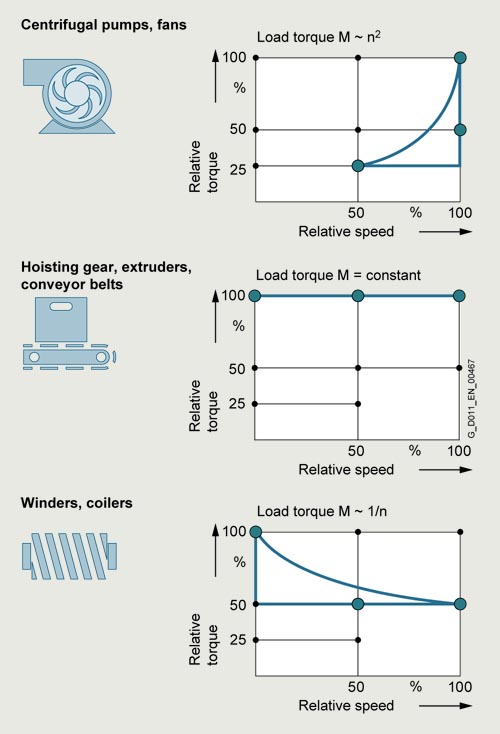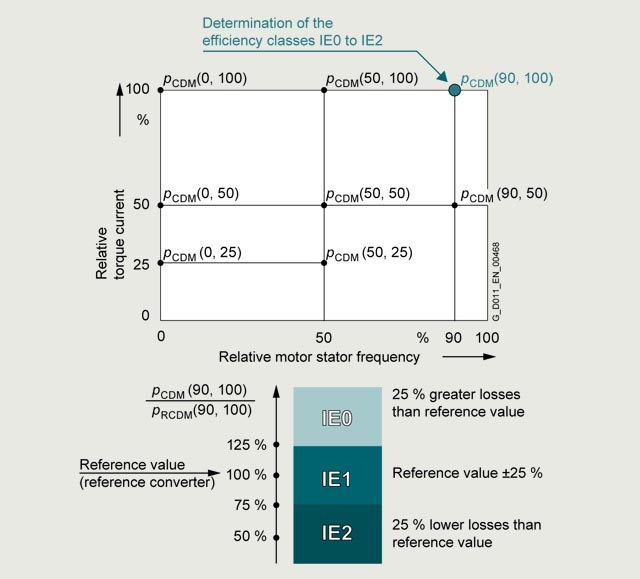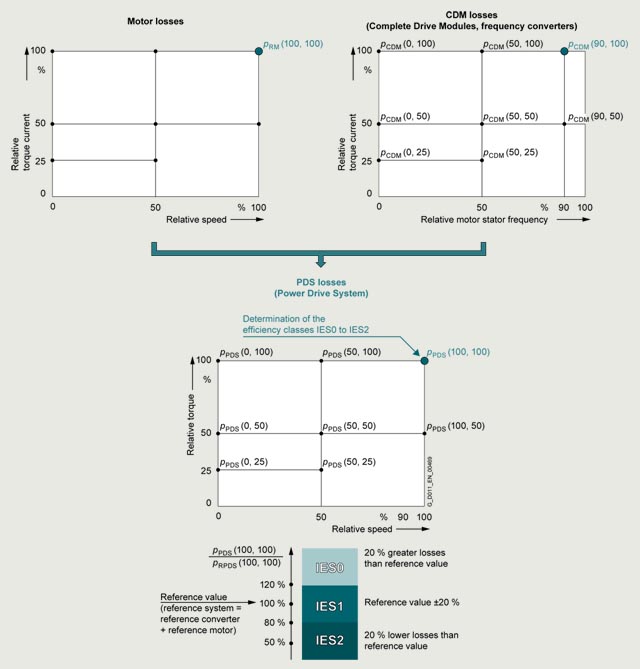ENG_483800.XML
Step by step to more efficiency
One of the core objectives of the European Union is a sustainable power industry. In industrial plants today, around 70 % of the power demand is from electrically driven systems. This high percentage contains huge potential for saving energy in electrical drives. For that reason, the European Union introduced minimum requirements for the energy efficiency of electric motors in the form of a statutory motor regulation as early as 2011.
These activities are expanded by EU Directive 2019/1781, which deals with more stringent requirements for DOL motors (Direct On Line) and defines the efficiency limits for frequency converters. The directive offers a legal basis for technical content in terms of the efficiency of specific products and services. However, standardization plays a leading role in determining the range and available market technology.
Improving energy efficiency is supported by a systematic selection of the most efficient converter and drive system technologies on the IEC 61800‑9 series of standards. Part 1 specifies the methodology to determine the energy efficiency index of an application on the basis of the expanded product approach (EPA) and semi-analytical models (SAMs), whereas part 2 entails indicators for the evaluation of the energy efficiency performance and classification of converters and drive systems.
First of all, the consideration of eight application-relevant operating points is introduced as mandatory, in order to take the different applications into account in a targeted manner. Determination of loss values at these eight points and definition of efficiency classes are laid down by the standard in a uniform way. This enables data relevant to operation, such as application-specific load profiles, to now be taken into account more easily in the energy efficiency analysis.
The standard is especially important for variable-speed drives of the following types:
- for AC/AC converters without energy recovery functionality
- for motors with integrated converters
- for supply voltages of 100 V to 1000 V
- for power ratings of 0.12 kW to 1000 kW
To cover all applications of driven machines, the IEC 61800‑9‑2 standard defines operating points in full-load and partial-load operation, at which the losses of the motor and drive systems have to be determined. Based on the loss data at the operating points in partial-load operation, variable-speed drives can be explicitly considered in more detail. This makes their advantages especially clear.

G_D011_XX_00467
Duty cycles for different driven machines
Moreover, frequency converters and motor systems are classified in efficiency classes, which permit an initial rough estimate of the potential saving. Definition of reference systems is a key aspect of this because they provide standard reference values. The positioning of these reference systems defines the efficiency class. The relative distance from the reference system can be used as an absolute measure of the efficiency at the operating point in question.
Advantages of the detailed loss consideration of IEC 61800‑9‑2 over the previous consideration of efficiencies and maximum loss values
For motors, the efficiency consideration was previously only defined for operation without a converter at 50/60 Hz. It provides a good way of comparing the energy efficiency of motors from different manufacturers for this use case.
The more detailed loss analysis of IEC 61800‑9‑2, on the other hand, is aimed at speed-controlled operation and therefore now also includes motors especially designed for converter operation in the energy analysis. These were previously not covered by the applicable standards.
Moreover, a loss analysis over the entire setting and load range of the motor is possible. This is done in accordance with the standard IEC 61800‑9‑2 with typical values.
For holistic consideration, it is essential to include all the relevant components of a drive system. The IEC 61800‑9‑2 standard defines this in detail. The standardized expression of power loss data as a percentage makes comparison considerably easier and more transparent.
The method also makes it possible to consider a motor that produces a holding torque at speed zero, for example. In this case, the efficiency is zero, but a power loss from current producing magnetization and holding torque does occur. In summary, the key advantage of standard IEC 61800‑9‑2 is the ability to perform the energy analysis of an electrical drive system based on standardized load profiles in all operating ranges due to uniform general conditions. This provides the user with complete transparency irrespective of the manufacturer.
Establishing efficiency classes of frequency converters (Complete Drive Modules CDM)
To avoid overmodulation and to ensure comparability between makes, which cannot be achieved otherwise, the efficiency classes of CDMs refer to the 90/100 operating point (90 % motor stator frequency, 100 % torque current).
Standard IEC 61800‑9‑2 defines the relative losses of a CDM in efficiency classes IE0 to IE2. With reference to the value of a CDM of efficiency class IE1 (reference converter), a CDM of efficiency class IE2 has 25 % lower losses and a CDM of efficiency class IE0 has 25 % higher losses.
The publication of EU Directive 2019/1781 makes compliance with the eco-design requirements for the product declaration of conformity mandatory.
AC/AC transformers, that belong to the aforementioned categories (specific voltage and performance level without regenerative feedback capability), must meet efficiency class IE2, in order to be authorized for installation/use within the EU.
Operating points for CDMs

G_D011_XX_00468
Complete Drive Module (CDM) – determining the efficiency class
Establishing the efficiency classes of drive systems (Power Drive Systems PDS)
What is possible for the individual systems, of course, also applies to the entire electrical PDS (frequency converter plus motor). Detailed comparisons are now possible at this level, too. The reference values for the reference system provide clear indications of the energy performance of the PDS.
Because targeted matching of the motor and CDM provides additional potential for optimization in electrical drive systems, it is especially important for the user to consider the entire drive system.
For the efficiency class of a PDS, too, a specific load point is defined. In this case, the reference point used is the 100/100 operating point (100 % motor stator frequency, 100 % torque).
Standard IEC 61800‑9‑2 defines the relative losses of a PDS in efficiency classes IES0 to IES2. With reference to the value of a PDS of efficiency class IES1 (reference drive), a PDS of efficiency class IES2 has 20 % lower losses and a PDS of efficiency class IES0 has 20 % higher losses.
Operating points for PDS

G_D011_XX_00469
Power Drive System (PDS) – determining the efficiency class